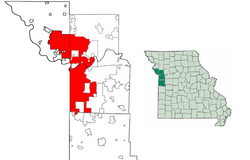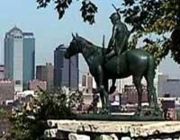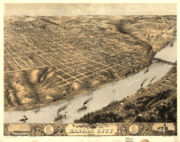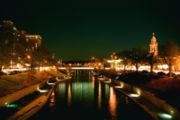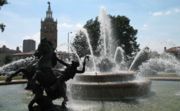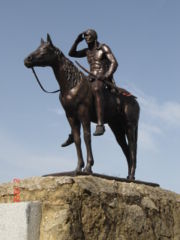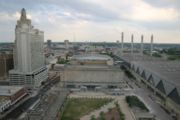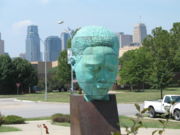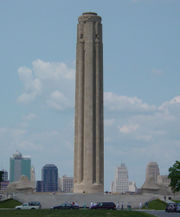Kansas City, Missouri
2007 Schools Wikipedia Selection. Related subjects: North American Geography
| Kansas City, Missouri | |||||
|
|||||
| Nickname: ""City of Fountains" or "Heart of America"" | |||||
| Location in Jackson, Clay, Platte, and Cass Counties in the state of Missouri. | |||||
| Coordinates: | |||||
|---|---|---|---|---|---|
| Country | United States | ||||
| State | Missouri | ||||
| Counties | Jackson, Clay, Platte, and Cass | ||||
| Incorporated | March 28, 1853 | ||||
| Mayor | Kay Waldo Barnes | ||||
| Area | |||||
| - City | 823.7 km² (318.0 sq mi) | ||||
| - Land | 812.1 km² (313.5 sq mi) | ||||
| - Water | 11.6 km² (4.5 sq mi) | ||||
| - Urban | 1513.6 km² (584.4 sq mi) | ||||
| Elevation | 231 m (758 ft) | ||||
| Population | |||||
| - City (2005) | 444,965 | ||||
| - Density | 543.7/km² (1,408.2/sq mi) | ||||
| - Urban | 1,361,744 | ||||
| - Metro | 1,947,694 | ||||
| Time zone | CST ( UTC-6) | ||||
| - Summer ( DST) | CDT ( UTC-5) | ||||
| Website: http://www.kcmo.org/ | |||||
Kansas City is a city in the US state of Missouri encompassing parts of Jackson, Clay, Cass, and Platte counties. It is situated at the junction of the Missouri and Kansas Rivers ( Kaw Point) and sits opposite Kansas City, Kansas. It is the largest city in the Kansas City Metropolitan Area, the most populous city in Missouri, the seventh largest city in the Midwest, and the 40th most populous city in the United States. As of 2005, the city had an estimated population of 444,965. The city's tap water was recently rated the cleanest among the 50 largest cities in the United States, containing no detectable impurities.
Abbreviations and nicknames
Kansas City, Missouri is often abbreviated as "KCMO", or just "KC" (although this often refers to the entire metro area). It is officially nicknamed the City of Fountains, with over 200 installations, ranking second in the world and exceeded only by Rome. It is also nicknamed the Heart of America because it is within 250 miles (400 km) of both the geographic and population centers of the United States. Informal nicknames include Jazz Capital of the World, Cowtown, and the BBQ Capital of the World, while residents are known as Kansas Citians.
History
Kansas City, Missouri was first incorporated in 1850.
Exploration and settlement
The French explorers Louis Joliet and Jacques Marquette were the first Europeans to explore the area that came to be known as Kansas City, during a six-day canoe trip up the Missouri River in 1673. The French first settled at St. Louis in the lower Missouri Valley in 1765. François Chouteau established Chouteau Landing at the confluence of the Missouri and Kansas rivers in 1821.
In 1833 John McCoy established West Port along the Santa Fe Trail, three miles away from the river. Then in 1834, McCoy established Westport Landing on a bend in the Missouri River to serve as a landing point for West Port. Soon after, the Kansas Town Company, a group of investors, began to settle the area, and in 1850 the landing area was incorporated as the Town of Kansas.
By that time, the Town of Kansas, Westport, and nearby Independence had become critical points in America's westward expansion. Three major trails - the Santa Fe, California, and Oregon - all originated in Jackson County.
On February 22, 1853 the City of Kansas was created with a newly elected mayor. It had an area of 0.98 square miles and a population of 2,500. The boundary lines at that time extended from the middle of the Missouri River south to what is now Ninth Street, and from Bluff Street on the west to a point between Holmes and Charlotte Streets on the east.
Civil War
The area was ripe with animosity as the Civil War approached. As a slave state, Missourians tended to sympathize with the southern states. With Kansas petitioning to enter the Union under the new doctrine of popular sovereignty, many from the area crossed into Kansas to sway the state towards allowing slavery, at first by ballot box and then by bloodshed.
During the Civil War, the City of Kansas was in the midst of battles, almost all of them victories by the Union. The Battle of Independence in August of 1862 stunted a Confederate advance into northern Missouri (settled by pro-slavery Virginians), and the October 1864 Battle of Westport effectively ended Confederate efforts to occupy the city. However, a successful raid on Lawrence, Kansas led by William Quantrill forced General Thomas Ewing to issue General Order No. 11, forcing the eviction of residents in four counties, including Jackson, except those living in the city and nearby communities, or those whose allegiance to the Union was certified by Ewing.
Post-Civil War
After the Civil War, the City of Kansas grew rapidly. The selection of the city over Leavenworth, Kansas for the Hannibal & St. Joseph Railroad bridge over the Missouri River brought about significant growth. The population exploded after 1869, when the Hannibal Bridge, designed by Octave Chanute, opened. The boom prompted a name change to Kansas City in 1889 and the city limits to extend south and east. Westport became part of Kansas City on December 2, 1897.
Kansas City, guided by architect George Kessler, became a forefront example of the City Beautiful movement, developing a network of boulevards and parks around the city. The relocation of Union Station to its current location in 1914 and the opening of the Liberty Memorial in 1923 gave the city two of its most identifiable landmarks. Further spurring Kansas City's growth was the opening of the innovative Country Club Plaza development by J.C. Nichols in 1925 as part of his Country Club District plan.
Pendergast era
At the turn of the century, political machines attempted to gain clout in the city, with the one led by Tom Pendergast emerging as the dominant machine by 1925. A new city charter passed that year made it easier for his Democratic Party machine to gain control of the city council (slimmed from 32 members to nine) and appoint a crooked city manager. The machine fell in 1939 when Pendergast, riddled with health problems, pleaded guilty to tax evasion. The machine, however, gave rise to Harry S. Truman, who quickly became Kansas City's favorite son.
Post-WWII sprawl
After World War II, the city experienced considerable sprawl, as the affluent populace bolted for suburbs like Johnson County, Kansas and eastern Jackson County. However, many also went north of the Missouri River, where Kansas City had incorporated areas during the 1920s and in 1963. This annexation would pay off for the city in the 1970s, when a population and developmental boom occurred in both Platte and Clay counties, bringing more buisinesses to the Northland and making many of the landowners in the area millionares. The population of the city proper dipped, but over the past 15 years has rebounded to nearly 450,000. Not only has growth in annexed areas (as far north as Smithville and south as Cass County) contributed to the growth, but also successful efforts to revitalize the downtown area. Such growth and ability to annex surrounding areas has allowed Kansas City to surpass St. Louis as the largest single municipality in the state of Missouri.
Notable Kansas Citians
Kansas City has served as a launching pad for several storied careers. Ernest Hemingway wrote for the Kansas City Star during World War I. Walt Disney moved to Kansas City and established his first animation studio, Laugh-O-Gram Studio, at 31st and Locust in 1923. Early screen actors Jean Harlow, Ginger Rogers and Craig Stevens, writers Robert Heinlein, William Least Heat Moon and director Robert Altman all grew up in Kansas City.
Geography
According to the United States Census Bureau, the city has a total area of 318.0 mi² (823.7 km²). 313.5 mi² (812.1 km²) of it is land and 4.5 mi² (11.6 km²) of it (1.41%) is water.
Kansas City is often imagined by outsiders to be flat like Chicago, Dallas or New York, but in fact it has many rolling hills. Kansas City proper is bowl-shaped and is surrounded to the north and south by limestone and bedrock cliffs that were carved by glaciers. Kansas City is situated at the junction between the Dakota and Minnesota ice lobes during the maximum late Independence glaciation of the Pleistocene epoch. The Kansas and Missouri rivers cut wide valleys into the terrain when the glaciers melted and drained. A partially filled spillway valley crosses the central portion of Kansas City, Missouri. This valley is an eastward continuation of Turkey Creek valley. Union Station is located in this valley.
Climate
Kansas City lies almost in the exact geographic centre of the continental United States, at the confluence of the second largest river in the country, the Missouri River, and the Kansas River (also known as the Kaw River). This makes for a continental climate with moderate precipitation and extremes of hot and cold. Summers can be very humid, with moist air riding up from the Gulf of Mexico, and July/August daytime highs reaching into the triple digits. Winters vary from mild days to bitterly cold, with lows reaching into the teens below zero a few times a year. Spring and Autumn are pleasant, and peppered with thunderstorms.
| Month | Jan | Feb | Mar | Apr | May | Jun | Jul | Aug | Sep | Oct | Nov | Dec | Year |
|---|---|---|---|---|---|---|---|---|---|---|---|---|---|
| Avg high °F (°C) |
38 (3) |
44 (7) |
56 (13) |
67 (19) |
76 (24) |
86 (30) |
90 (32) |
89 (32) |
80 (27) |
69 (21) |
53 (12) |
42 (7) |
66 (19) |
| Avg low °F (°C) |
21 (-6) |
26 (-3) |
36 (2) |
46 (8) |
57 (14) |
67 (19) |
72 (22) |
70 (21) |
61 (16) |
49 (9) |
36 (2) |
25 (-4) |
47 (8) |
| Rainfall in inches (millimeters) |
1.13 (28.7) |
1.02 (25.9) |
2.38 (60.5) |
3.27 (83.1) |
4.55 (115.6) |
4.73 (120.1) |
3.61 (91.7) |
3.62 (91.9) |
4.17 (105.9) |
3.28 (83.3) |
2.30 (58.4) |
1.45 (36.8) |
35.51 (902) |
Weather
Kansas City is situated in " Tornado Alley", a broad region where cold air from the Rocky Mountains and Canada collides with warm air from the Gulf of Mexico, leading to the formation of powerful storms. Kansas City has had many severe outbreaks of tornados, including the Ruskin Heights tornado in 1957, and the May 2003 Tornado Outbreak Sequence. The region is also prone to ice storms, such as the 2002 ice storm during which hundreds of thousands lost power for days and (in some cases) weeks. Kansas City and its outlying areas are also subject to flooding, including the Great Flood of 1993 and the Great Flood of 1951.
Cityscape
Kansas City, Missouri, is organized into a system of more than 150 neighborhoods, some with histories as independent cities or the sites of major events.
Downtown, the centre of the city, is currently undergoing major redevelopment. Downtown Kansas City has a variety of neighborhoods, including historical Westport, the Crossroads Arts District, 18th and Vine Historic District, Pendleton Heights, Quality Hill, the West Bottoms and the River Market.
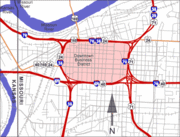
Other areas near Downtown Kansas City include:
The 39th Street District is known as Restaurant Row and features one of Kansas City's largest selections of independently owned restaurants and boutique shops. It is a centre of literary and visual arts and bohemian culture.
Crown Centre is the headquarters of Hallmark Cards and a major downtown shopping and entertainment complex. It is connected to Union Station by a series of covered walkways.
The Country Club Plaza is an upscale, outdoor shopping district. It was the first shopping district in the United States designed to accommodate shoppers arriving by automobile.
Kansas City's Union Station is now home to Science City, restaurants, shopping, theaters, and the city's Amtrak facility.
Ward Parkway is a beautiful, landscaped boulevard known for its European art and historic large houses.
Downtown redevelopment
Downtown Kansas City is an area of 2.9 square miles bounded by the Missouri River to the north, 31st Street to the south, Bruce R. Watkins Drive ( U.S. Highway 71) to the east and I-35 to the west.
After years of neglect and seas of parking lots, downtown Kansas City is currently undergoing a period of change. Many residential properties have recently been or are currently under redevelopment. A planned entertainment district, which will be called the "Power and Light District", is being developed in the southern part of the downtown freeway loop by the Cordish Company of Baltimore, Maryland; adjacent to the entertainment district will be a new arena, named the Sprint Centre, set to open in 2007. The arena is to be designed by a consortium of local architects, and hopes to lure an NBA or NHL franchise to the city. Los Angeles-based Anschutz Entertainment Group has invested in the arena project and will run its daily operations.
Parks and parkways
Kansas City is well-known for its spacious parkways and numerous parks. The parkway system winds its way through the city with broad, landscaped medians that include statuary and fountains. One of the best examples is Ward Parkway on the west side of the city, near the Kansas state line.
Swope Park is one of the nation's larger in-city parks, comprising 1,763 acres (2.75mi²) . It includes a full-fledged zoo, two golf courses, a lake, an amphitheatre, day-camp area, and numerous picnic grounds.
Kansas City has always had one of the nation's best urban forestry programs. At one time, almost all residential streets were planted with a solid canopy of American elms but Dutch elm disease devastated them. Most of the elms died and were replaced with a variety of other shade trees. A program is underway currently to replace many of the fast-growing sweetgum trees with hardwood varieties.
Demographics
| Historical populations | ||
|---|---|---|
| Census | Pop. | %± |
| 1870 | 32,260 | |
| 1880 | 55,785 | 73% |
| 1890 | 132,716 | 138% |
| 1900 | 163,752 | 23% |
| 1910 | 248,381 | 52% |
| 1920 | 324,410 | 31% |
| 1930 | 399,746 | 23% |
| 1940 | 400,178 | <1% |
| 1950 | 456,622 | 14% |
| 1960 | 475,539 | 4% |
| 1970 | 507,087 | 6% |
| 1980 | 448,159 | -12% |
| 1990 | 435,146 | -3% |
| 2000 | 441,545 | 1% |
| 2010 est | 456,789 | |
As of the census GR2 of 2000, there are 441,545 people, 183,981 households, and 107,444 families residing in the city. The population density is 543.7/km² (1,408.2/mi²). There are 202,334 housing units at an average density of 645.3/km² (249.2/mi²). The racial makeup of the city is 60.68% White, 31.23% African American or Black, 0.48% Native American, 1.85% Asian, 0.11% Pacific Islander, 3.21% from other races, and 2.44% from two or more races. 6.93% of the population are Hispanic or Latino of any race.
There are 183,981 households out of which 28.1% have children under the age of 18 living with them, 38.0% are married couples living together, 16.0% have a female householder with no husband present, and 41.6% are non-families. 34.1% of all households are made up of individuals and 9.4% have someone living alone who is 65 years of age or older. The average household size is 2.35 and the average family size is 3.06.
In the city the population is spread out with 25.4% under the age of 18, 9.7% from 18 to 24, 32.5% from 25 to 44, 20.6% from 45 to 64, and 11.7% who are 65 years of age or older. The median age is 34 years. For every 100 females there are 93.3 males. For every 100 females age 18 and over, there are 89.9 males.
The median income for a household in the city is $37,198, and the median income for a family is $46,012. Males have a median income of $35,132 versus $27,548 for females. The per capita income for the city is $20,753. 14.3% of the population and 11.1% of families are below the poverty line. Out of the total people living in poverty, 20.2% are under the age of 18 and 10.5% are 65 or older.
The United States Census bureau updated their American Community Survey information in 2005 for Kansas City. Their study estimated a population of about 440,885 people, the margin of error was placed at +/- 9,193 people. Growth in Kansas City is increasing, with 3,618 housing permits granted in 2004 and 2005. As of 2005, about 210,000 households exist.
Economy
Greater Kansas City is headquarters to 4 Fortune 500 companies ( H&R Block, Embarq Corporation, Sprint Nextel Corporation, and YRC Worldwide Inc.) and five additional Fortune 1000 corporations ( Interstate Bakeries Corporation, Great Plains Energy, Aquila, Inc., AMC Theatres, and DST Systems). Hallmark Cards's gross revenues certainly would qualify it for both lists, but it cannot be included because it is privately owned by the Hall family. Numerous agriculture companies operate out of the city and the Kansas City Board of Trade is the principal trading centre for hard red winter wheat — the principal ingredient of bread.
The business community is serviced by two major business magazines, the Kansas City Business Journal (published weekly) and Ingram's Magazine (published monthly), as well as numerous other smaller publications, including a local society journal, the Independent (published weekly).
Law and government
The current mayor of Kansas City, Missouri is Kay Barnes, the city's first female mayor. Elected in March 1999 and again in March 2003, her second of two terms will expire in April 2007. The city has a city manager form of government, however the role of city manager has diminished over the years following excesses during the heyday of Tom Pendergast.
From the late 19th Century to the mid 20th Century, Kansas City was controlled by often corrupt Democrat-controlled political machines. Tom Pendergast was the most infamous leader of the party machine. The most prominent Democrat to rise out of Pendergast's machine was Harry S. Truman, who became a Senator, Vice President of the United States and then President of the United States from 1945- 1953.
Kansas City has hosted the 1900 Democratic National Convention, the 1928 Republican National Convention, which nominated Herbert Hoover from Iowa for President, and the memorable 1976 Republican National Convention, which nominated Kansas U.S. Senator Bob Dole for Vice President.
Kansas City consistently votes Democractic in Presidential elections, however on the state and local level Republicans often find some modest success. Missouri was a Blue state in the 1996 Presidential election and Red state in the 2000 and 2004 Presidential elections. Since Kansas City borders on the state of Kansas which consistently votes Republican, and since the suburbs of Kansas City typically vote Republican, the city is sometimes associated with Republicans.
Crime
As of October 30, 2006, Kansas City ranks as twenty first highest amount of crime in the United States, as reported by the FBI.
Kansas City ranked eighth in rate of murders in the 2004 United States cities by crime rate for cities with populations more than 400,000. The entire Kansas City metropolitan area has the fourth worst violent crime rate among cities with more than 100,000 with a rate of 614.7 crimes per 100,000 residents.
Most of the city's murders and violent crimes occur in the city's inner core. The violent crime rates in the core have consistently driven the city and metropolitan area down on "livability" indexes, hindering initiatives in the 1970s, 1980s and 1990s to revive downtown Kansas City. In recent years, however, attempts at revitalizing the downtown area have been more successful. Downtown currently has one of the lowest crime rates in the urban core, and thousands more people have moved to this area. However, other parts of the urban core with higher poverty levels remain places where crime is unabated.
Some of the earliest violence in Kansas City erupted during the bloody American Civil War. Shortly after its founding in 1853, the Bleeding Kansas incidents erupted affecting border ruffians and Jayhawkers who both lived in the city. During the war, Union troops burned all occupied dwellings in Jackson County south of Brush Creek and east of Blue Creek to Independence in an attempt to halt raids into Kansas.
After the war, the Kansas City Times turned Jesse James into a folk hero in its coverage. James was born in the metro area at Kearney, Missouri and robbed the Kansas City Fairgrounds at 12th and Campbell.
In the early 20th Century under "Boss" Tom Pendergast, Kansas City became the country's "most wide open town", with virtually no enforcement of liquor laws or hours. While this would give rise to Kansas City Jazz, it also led to the rise of the Kansas City mob (initially under Johnny Lazia) as well as the arrival of gangsters. The 1930's saw the Kansas City Massacre at Union Station, as well as a shootout between police and outlaws Bonnie and Clyde at the Red Crown Tavern near what is now Kansas City International Airport.
In the 1970s, the Kansas City mob was involved in a gangland war over control of the River Quay entertainment district in which three buildings were bombed and several gangsters were killed. Police investigations into the mob took hold after boss Nick Civella was recorded discussing gambling bets on Super Bowl IV (where the Kansas City Chiefs defeated Minnesota). The war and investigation would lead to the end of mob control of the Stardust Casino, which was the basis for the movie Casino (although the Kansas City connections are minimized in the movie).
On November 1, 2004, musician Andre "Mac Dre" Hicks was killed in Kansas City after performing a concert. Later, Anthony "Fat Tone" Watkins was killed in retaliation for the death of Mac Dre. Mac Minister was taken to prison for the murder of Fat Tone.
Sister cities
 Tainan City, Taiwan
Tainan City, Taiwan Seville, Spain
Seville, Spain Xi'an, People's Republic of China
Xi'an, People's Republic of China Freetown, Sierra Leone
Freetown, Sierra Leone Ramla, Israel
Ramla, Israel Port Harcourt, Nigeria
Port Harcourt, Nigeria San Nicolas de los Garza, Mexico
San Nicolas de los Garza, Mexico Kurashiki, Japan
Kurashiki, Japan Metz, France
Metz, France Guadalajara, Mexico
Guadalajara, Mexico Hannover, Germany
Hannover, Germany Arusha, Tanzania
Arusha, Tanzania Morelia, Mexico
Morelia, Mexico
Transportation
Kansas City owes its existence as a major city to its crossroads status.
First, it was at the confluence of the Missouri River and Kansas River and the launching pointing for travelers on the Santa Fe, Oregon, and California trails. Then with the construction of the Hannibal Bridge across the Missouri River it became the central location for 11 trunk railroads. More rail traffic in terms of tonnage still passes through the city than any other city in the country. TWA located its headquartes in the city and had ambitious plans to turn the city into an air hub for the world.
Missouri and Kansas were the first states to start building interstates with Interstate 70. An ever increasing number of interstate loops has encouraged suburban sprawl.
Airports
Kansas City International Airport was built to the specifications of TWA to make a world hub for the supersonic transport and Boeing 747. Its passenger friendly design in which its gates were 100 feet from the street has, since the September 11, 2001 attacks, required a costly overhaul to retrofit it to incorporate elements of a more conventional security system.
Charles B. Wheeler Downtown Airport was the original headquarters of Trans World Airlines and houses the Airline History Museum. It is still used for general aviation and airshows.
Mass transit
In the first half of the 20th century, Kansas City's mass transit system was rail-based with its interurban running from Kansas City more than 50 miles in all directions between 1900 and 1939. In addition, Kansas City had an electric trolley network that ran through the city until 1959.
Bus rapid transit
In July 2005, the Kansas City Area Transportation Authority started a new bus system called, "The MAX" (Metro Area Express). The bus route starts in the City Market in Downtown Kansas City, and has many stops along Main Street, The Plaza and southern Kansas City. At the time of their introduction, MAX buses were to be able to prolong green traffic lights to stay on schedule, but as of September, 2006, this technology has not been put into effect.
- Buses run 7 days a week from 5:00am to 1:00am. During rush hour periods, the buses make stops every 10 minutes. All other times, the buses make stops every 15-30 minutes. Each bus ride costs $1.25. Kansas City also has the METRO bus system which runs through the whole Kansas City Area. Between June 1 and September 20, the fare is reduced to $0.25 on days for which the amount of ground level ozone is predicted to be high.
Light rail
- Kansas City does not have a subway or light rail system, and several proposals to build one have been rejected by voters in the past. On November 7, 2006, a measure proposing a light rail system was passed with a majority of 53 percent. This measure would see light rail running from the Kansas City Zoo, through the urban core, and out to Kansas City International Airport. There has been some criticism of the funding plan.
Culture
Architecture
Kansas City has long been praised for its varied architecture, which includes many famous and interesting buildings. Its skyline is notable for various structures, including the immense Bartle Hall Convention Centre, the adjoined art deco Municipal Auditorium, and numerous skyscrapers such as the Kansas City Power and Light Building and One Kansas City Place (the tallest habitable structure in Missouri), as well as the KCTV-Tower (the tallest freestanding structure in Missouri and 39th tallest tower in the world), and the Liberty Memorial (the national World War I memorial and museum of the United States).
City of Fountains
With more than 200 fountains, Kansas City claims that only Rome has more fountains. The fountain is a logo for the city.
Kansas City cuisine
Kansas City is most famous for its steak and barbeque.
Kansas City steaks
During the heyday of the Kansas City Stockyards, the city was known for its Kansas City steaks or Kansas City strip steaks. The most famous of the steakhouses is the Golden Ox in the Kansas City Live Stock Exchange in the stockyards in the West Bottoms. The stockyards, which were second only to those of Chicago in size, never recovered from the Great Flood of 1951 and eventually closed. The famed Kansas City Strip cut of steak is largely identical to the New York Strip cut, and is sometimes referred to just as a strip steak.
Kansas City-style barbecue
Along with Texas, Memphis & North Carolina, Kansas City is a "world capital of barbecue." There are more than 90 barbecue restaurants in the metropolitan area and the American Royal each fall hosts what it claims is the world's biggest barbecue contest.
The classic Kansas City-style barbecue was an inner city phenomenon that evolved from the pit of Henry Perry from the Memphis, Tennessee area in the early 1900s and blossomed in the 18th and Vine neighbourhood. Arthur Bryant's was to take over the Perry restaurant and added molasses to sweeten the recipe. In 1946 Gates and Sons Bar-B-Q was opened by one of Perry's cooks. The Gates recipe added even more molasses. Although Bryant's and Gates are the two definitive Kansas City barbecue restaurants they have had little or no luck exporting the barbecue beyond the Kansas City metropolitan area.
In 1977 Rich Davis, a child psychologist, test-marketed his own concoction called K.C. Soul Style Barbecue Sauce. He renamed it KC Masterpiece and in 1986 he sold the sauce to the Kingsford division of Clorox. Davis retained rights to operate restaurants using the name and sauce, with a restaurant in the suburb of Overland Park, KS.
One of the most popular and recognized BBQ establishments in Kansas City is Fiorella's Jack Stack Restaurant. As of November 2006, the Fiorella family has 4 restaurants in the Kansas CIty area. Russ Fiorella started the chain in 1957 and then continued by his son, Jack and Jack's wife Delores. Jack and Delores are responsible for introducing hickory-smoked meats and side-dishes to the menu. Jack Stack has a reputation as one of the highest quaility BBQ restaurants, offering seafood, lamb, Angus beef and chicken.
Kansas City Jazz
Kansas City Jazz in the 1930s marked the transition from big bands to the bebop influence of the 1940s. In the 1930s City Boss Tom Pendergast was at his height of his power and left Kansas City a wide open town in which night clubs were allowed to remain open from dusk to dawn. In this venue, an era of musical improvisation developed in which it was not uncommon for a single "song" to be performed all night by competing performers who passed through the city. The era ended in 1936 when producer John H. Hammond began signing Kansas City talent and transferring the acts to New York City.
The era of Kansas City influence is bracketed by the signing of Count Basie in 1929 to the advent of Kansas City native Charlie Parker in the 1940s. Pendergast pleaded guilty to income tax evasion in 1939 and the city soon began a crackdown of the clubs.
In the 1970s Kansas City attempted to resurrect the glory of the jazz era in a sanitized family friendly atmosphere. In the 1970s an effort to open jazz clubs in the River Quay area of City Market along the Missouri ended in a gangland war in which three of the new clubs were blown up in what ultimately resulted in the removal of Kansas City mob influence in the Las Vegas casinos that was partially depicted in the movie Casino (movie).
In 1981, 114 people died in the Hyatt Regency walkway collapse at a tea dance that was attempting to recreate the jazz era. In 1999 the American Jazz Museum opened in the 18th and Vine neighbourhood.
Music
Kansas City has an avid local music scene and is a very popular locale for many punk and hip-hop acts. Native rappers include Tech N9ne, Fat Tone, and Krizz Kiliko. Recent rock groups originating in Kansas City include Puddle of Mudd, Flee the Seen, and The Life and Times.
Sports
Current teams
Kansas City sports teams presently include the following:
| Club | Sport | Founded | League | Venue |
|---|---|---|---|---|
| Kansas City Royals | Baseball | 1969 | Major League Baseball : AL | Kauffman Stadium |
| Kansas City Chiefs | Football | 1963 | National Football League : AFC | Arrowhead Stadium |
| Kansas City Explorers | Tennis | 1993 | World TeamTennis | Barney Allis Plaza |
| Kansas City Wizards | Soccer | 1996 | Major League Soccer | Arrowhead Stadium |
| Kansas City Brigade | Arena Football | 2006 | Arena Football League | Kemper Arena/ Sprint Centre (2008) |
Sporting events
- Kansas City is often the home of the Big 12 College Basketball Tournaments. Men's Basketball is played at Kemper Arena, while women's Basketball is played at Municipal Auditorium. Lately newer arenas in Dallas and Oklahoma City have hosted the tournament. The new Sprint Centre will host the tournament in March 2008.
- Arrowhead Stadium serves as the venue for various intercollegiate football games. Often it is the host of the Big 12 Football Title Game.
On the last weekend in October, the Fall Classic rivalry game between Northwest Missouri State University and Pittsburg State University takes place here. Usually, the Bearcats of Northwest and Gorillas of Pitt State are ranked one-two in the MIAA conference. In 2005, other games at Arrowhead included Arkansas State playing host to Missouri, and Kansas hosting Oklahoma.
Sites of interest
Museums
- American Jazz Museum ( website)
- Negro Leagues Baseball Museum ( website)
- Nelson-Atkins Museum of Art (also site of the annual Jewel Ball)
- Kemper Museum of Contemporary Art
- Airline History Museum
- Toy and Miniature Museum of Kansas City
- Westport, oldest part of the city and a vibrant entertainment district.
- Kansas City ranks second in the world in number of fountains (over 200), exceeded only by Rome ( visitkc.com)
- Charlie Parker Memorial, at 17th Terrace and the Paseo
- Arabia Steamboat Museum ( www.1856.com), in the historic River Market.
- Kansas City Museum ( website), located in a beautifully renovated 1910 mansion.
- Harry S. Truman Presidential Library and Museum ( website), located in Kansas City suburb of Independence, MO.
Historical landmark
- Country Club Plaza ( website) -- first shopping centre designed to accommodate the automobile. Now considered one of the great urban shopping districts in America.
- Liberty Memorial ( website)-- Official World War I memorial and museum in the United States. Tower and observation deck restored and re-opened in 2002. Currently an even larger museum is being constructed underneath the monument.
- Laugh-O-Gram Studio ( www.laughograms.com), Walt Disney's original cartoon studio in Kansas City. Now being renovated.
Entertainment
- Worlds of Fun and Oceans of Fun
- Kansas City Zoo, in Swope Park.
- Kansas City Renaissance Festival ( website), annual festival that runs through the fall that features live entertainers, a medieval village, rides, games, sword fights, and more.
- Ameristar Casino Kansas City
- Isle of Capri
- Kansas City Irish Fest ( website), Labor Day weekend annually.
Educational institutions
Post-secondary
- Avila University
- Calvary Bible College
- DeVry University of Kansas City
- Kansas City Art Institute
- Kansas City College
- Kansas City University of Medicine and Biosciences (KCUMB)
- Metropolitan Community College-Kansas City ( website )
- MCC-Penn Valley
- MCC-Longview
- MCC-Maple Woods
- MCC-Business and Technology
- MCC-Blue River
- MCC-Longview
- Midwestern Baptist Theological Seminary
- National American University
- Nazarene Theological Seminary ( website )
- Park University ( )
- Rockhurst University
- University of Missouri - Kansas City (UMKC)
- University of Phoenix - Kansas City
- Webster University - Kansas City
- Vatterott College
Elementary and secondary
Kansas City is served by a variety of school districts.
School districts that serve Kansas City include:
- Centre 58 School District
- Grandview Consolidated No.4 School District
- Hickman Mills Consolidated No.1 School District
- Kansas City, Missouri School District.
- Lee's Summit R-VII School District
- Liberty Schools
- North Kansas City School District
- Park Hill School District
- Platte County School District
- Raytown Consolidated No.2 School District
- Smithville School District
Private schools in Kansas City include:
- The Barstow School
- Lutheran High School
- Notre Dame de Sion
- The Pembroke Hill School
- Rockhurst High School
- Archbishop O'Hara Highschool
- Saint Pius X High School
- Saint Teresa's Academy


